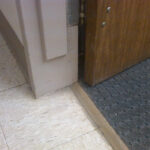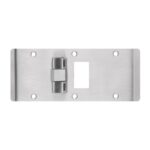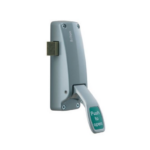This article will be published in an upcoming issue of Locksmith Ledger. If you think of something else a locksmith should know about codes pertaining to mechanical hardware, let me know! I will be adding some photos to the final piece.
Locksmiths are often called upon to increase security at an existing door or replace hardware that is damaged or defective. There are several code requirements to note before getting started.
The first step is to verify whether the door is a fire door assembly, a door in the means of egress, or a door on an accessible route. A fire door will typically have a label on the hinge edge, although the label may be difficult to see if it has been painted. An egress door might have an exit sign, but many egress doors do not. For example, a door leading from an individual office to a corridor won’t have an exit sign, but it is the egress route for the occupant of that office and is therefore part of the means of egress. Current building codes consider most doors to be part of an accessible route, unless the code specifically excludes them from the accessibility requirements. It is more difficult to determine whether an existing door is part of an accessible route, and it’s safest to assume that accessibility standards must be followed unless the Authority Having Jurisdiction (AHJ) approves an alternative.
Fire Door Assemblies
For fire door assemblies, modifications made in the field are limited by NFPA 80 – Standard for Fire Doors and Other Opening Protectives. Job-site preparations are limited to:
- round holes a maximum of 1 inch (25 mm) in diameter (except cylinder holes which may be any size), for preparation of surface-applied hardware, function holes for mortise locks, holes for labeled viewers, and through-bolts,
- a maximum 3⁄4 inch (19 mm) wood and composite door undercutting, and
- protection plates which are installed within the bottom 16 inches (406 mm) of the door – larger plates may be field-installed but must be labeled.
For field modifications on fire doors that are beyond the allowable job-site preparations, a written or graphic description of the proposed modifications must be provided to the listing laboratory via the manufacturer of the door or frame. The lab will evaluate the proposal and provide written authorization if the work is acceptable. If the door or frame manufacturer is no longer available, the lab may be contacted directly. Field modifications which do not have prior approval may require field inspection and relabeling by the listing laboratory, which can be costly.
Holes that are left when hardware is removed must be filled with steel fasteners or the same material as the door or frame. Also keep in mind that fire door assemblies must have an active latchbolt, to provide positive-latching and keep the door latched during a fire. If the latching hardware is removed, the fire door may not perform as designed and tested, and it will not pass a fire door inspection. Panic hardware used on fire doors must be fire exit hardware, which is labeled for this use and does not include a mechanical dogging mechanism.
Doors in a Means of Egress
Egress doors are required to unlatch with one operation, with a few exceptions. A door to a residential dwelling unit (individual apartment, hotel room) with an occupant load of 10 or less may have a separate nightlatch, deadbolt, or security chain, as long as it doesn’t require a key or tool to release it from the interior. This security device would require a second operation in addition to retracting the latchbolt of the the lockset or latchset. Other exceptions include places of detention or restraint (prisons, holding cells), doors where manual flush bolts are allowed, or doors with automatic flush bolts.
Doors that are not included on this list of exceptions must require only one operation to release the latch – for example, turning a lever or pushing a touchpad that is mounted between 34 inches (865 mm) and 48 inches (1220 mm) above the floor. A frequent violation of the egress requirements is to add a deadbolt or exit alarm to a door that already has another lock or latch.
The International Building Code (IBC) and NFPA 101 – The Life Safety Code allow the use of key-operated locks (double-cylinder deadbolts) in limited locations:
- Assembly occupancies within a specified occupant load (IBC: 300 occupants or less, NFPA 101: 500 occupants for new and 600 occupants for existing Assembly occupancies)
- Business, Factory, Mercantile, or Storage occupancies, or
- Places of religious worship (the IBC does not impose an occupant load limit).
Key-operated locks are limited to the main exterior door or doors in these occupancy types. The locking device must be readily distinguishable as locked – often the lock will have an indicator which reads “open” or “locked.” Signage on the egress side of the door or adjacent to the door must state “THIS DOOR TO REMAIN UNLOCKED WHEN BUILDING IS OCCUPIED.” A building official may revoke the use of a key-operated lock for due cause. NFPA 101 requires the key to be readily available to any occupant inside the building when the door is locked.
The use of key-operated locks on residential dwellings may vary by jurisdiction, but the International Residential Code (IRC) which applies to 1- and 2-family dwellings states: “Egress doors shall be readily openable from inside the dwelling without the use of a key or special knowledge or effort.” This requirement would prohibit the installation of a double-cylinder deadbolt on an egress door from a residence.
Another consideration is the requirement for panic hardware. This applies to doors with a latch or lock, that are part of a means of egress from an Assembly or Educational occupancy serving an occupant load of 50 or more (2006 IBC and subsequent editions), or 100 or more (2000-2003 editions of the IBC and all recent editions of NFPA 101). NFPA 101 recognizes Day Care facilities as a separate occupancy classification, and also requires panic hardware for those facilities with an occupant load of 100 or more. Panic hardware is also required for High Hazard occupancies, as well as rooms housing electrical equipment rated at more than 600 volts, or more than 800 amps, or battery rooms per the 2014 National Electrical Code (the IBC contains less stringent requirements for this). Doors with panic hardware must not have any additional locking devices such as deadbolts or surface bolts.
Doors on an Accessible Route
There are two national standards that address doors on an accessible route – ICC A117.1 – Accessible and Usable Buildings and Facilities, and the 2010 ADA Standards for Accessible Design. According to these standards, door hardware must have a shape that is easy to grasp with one hand, and does not require tight grasping, pinching, or twisting of the wrist to operate. The 2010 ADA Standards include an additional requirement by reference – hardware must be operable with a maximum of 5 pounds (22.2 N) of force. Operable hardware must be mounted between 34 inches (865 mm) and 48 inches (1220 mm) above the floor – the ADA standards include an exception for some existing locks, and A117.1 exempts locks used only for security purposes and not used for normal operation.
Operating hardware for sliding doors must be exposed and usable from both sides when the door is in the fully-open position. For pocket doors, this means that the door will not slide completely into the pocket because of the protruding hardware, which can affect the clear opening width (typically 32 inches (813 mm) minimum).
In order to definitively apply these requirements, it’s important to know which code is in effect for the project location, and which occupancy classification applies to the facility. A building permit is required by most jurisdictions for modifications that affect the means of egress. State or local codes may vary, and the Authority Having Jurisdiction is responsible for administration and enforcement of all code requirements.
You need to login or register to bookmark/favorite this content.






Maybe under panic hardware, add no other locking device allowed…dead bolt, slide bolts, etc.
Do not know if you want to get into drop bars or door indicators.
Exactly the kind of feedback I was looking for – thanks!!
I remember something about NFPA 101 requiring double keyed locks to have a key accessible to the occupants also…
I didn’t include this originally because it has more to do with the operation of the building than the installation of the hardware, but it could factor into the decision about whether to install a key-operated lock, so I added it! Thanks!
Must locksmith’s be certified to install new hardware on existing fire rated doors? If yes, who can I contact to get the locksmith’s certified.
Hi Eileen –
There is no code requirement that I know of for locksmiths to be certified to install hardware on fire doors. The job-site preparation would be limited to 1″ diameter holes (except cylinder holes which can be any size).
– Lori